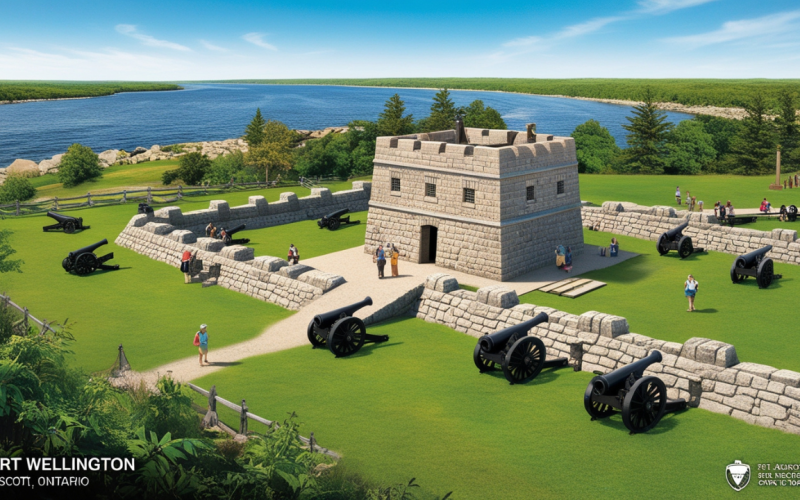Intro about Fort Wellington National Historic Site (Ontario)
Fort Wellington National Historic Site (Ontario) Prescott, Ontario, is a living monument to Canada’s military history. Sitting on the shores of the St. Lawrence River, it captures pivotal moments in Canada’s defence during the War of 1812 and the Upper Canada Rebellion of 1837-1838. This historic site offers a fascinating journey back in time, connecting you to the soldiers, loyalists, and local communities that shaped the region.
Key Takeaways
- Fort Wellington was crucial in protecting Upper Canada during the War of 1812 and the 1838 rebellions.
- It is one of Canada’s best-preserved nineteenth-century fortifications.
- The fort’s strategic location near the St. Lawrence River ensured the defence of vital communication routes.
- Visitors can explore unique features like the blockhouse, earthen ramparts, and barracks.
- Parks Canada preserves Fort Wellington to educate and inspire future generations.
What Makes Fort Wellington Unique?
Strategic Location in Prescott, Ontario
Fort Wellington sits in Prescott, overlooking the St. Lawrence River. This location made it a critical point for defending communication and supply routes between Kingston and Montreal during the War of 1812. The town’s proximity to the U.S. border heightened its importance during periods of conflict.
A Key Role in Two Historic Conflicts
The fort’s history spans two significant periods: the War of 1812 and the Upper Canada Rebellion of 1837-1838. Its ability to adapt and serve as a military hub during both conflicts highlights its strategic importance and enduring legacy.
The First Fort Wellington
Origins During the War of 1812
The first Fort Wellington was constructed in 1813 to protect Upper Canada from American raids. At that time, Captain Benjamin Forsyth and his troops frequently crossed the frozen St. Lawrence River to attack Canadian settlements. Fort Wellington served as a defensive barrier, securing key communication routes and supply lines.
Key Features of the First Fort
The original fort included basic structures such as earthen ramparts, a simple blockhouse, and a dry ditch. These defences were designed to withstand artillery fire and provide shelter for the British regulars and local militia stationed there.
Abandonment After the War
After the War of 1812 ended in 1814, the fort was abandoned and fell into disrepair. While it was no longer operational, its role in securing the region’s stability during the war remained a critical part of its history.
The Second Fort Wellington
Reconstruction in 1838
Political unrest during the Upper Canada Rebellion led to the reconstruction of Fort Wellington. This second version was stronger and more advanced, featuring masonry blockhouses, earthen ramparts, and reinforced barracks.
The Battle of the Windmill
In November 1838, the Battle of the Windmill became a defining moment for the fort. British and loyalist forces used Fort Wellington as an assembly point to counter American sympathizers attempting to incite rebellion. This victory underscored the fort’s significance in maintaining peace and order in the region.
Enhanced Defenses and Features
The second fort was equipped with improved features, such as thicker walls, new palisades, and expanded barracks. These upgrades ensured it could withstand future threats and remain a stronghold for loyalist forces.
Timeline of Fort Wellington’s History
| Year | Event | Significance |
| 1813 | First, Fort Wellington was built | Defence during the War of 1812 |
| 1837-1838 | Rebuilt as Second Fort Wellington | Response to the Upper Canada Rebellion |
| 1838 | Battle of the Windmill | Key engagement against American sympathizers |
| Early 20th C | Declared National Historic Site of Canada | Preserved by Parks Canada |
Life Inside the Fort
The Role of the Blockhouse
The blockhouse was the heart of Fort Wellington. This multi-purpose structure provided living quarters for soldiers, storage for supplies, and a last line of defence during attacks. Its sturdy masonry design made it a formidable feature of the fort.
Daily Life for Soldiers and Families
Fort Wellington wasn’t just a military base—it was a community. Soldiers lived alongside their families within the fort, sharing tight quarters in the barracks. Daily routines included military drills, maintenance of the fortifications, and tending to livestock.
Additional Facilities
The fort also included a gunpowder magazine, latrines, and a dry ditch for added defence. These facilities supported the daily operations of the garrison and reinforced the fort’s readiness for conflict.
Cultural and Historical Significance
Connection to the War of 1812
The War of 1812 established Fort Wellington as a critical defensive site. Its role in protecting Upper Canada from American forces ensured the survival of key communication routes and supply lines.
Impact of the Upper Canada Rebellion
During the 1837-1838 rebellion, the fort became a symbol of stability and resistance against rebellion forces. Its use during the Battle of the Windmill highlighted its strategic importance in defending the region.
Preservation by Parks Canada
Today, Fort Wellington is maintained by Parks Canada, ensuring its commemorative integrity and accessibility for future generations. Its preservation helps connect visitors to Canada’s military heritage.
Visiting Fort Wellington Today
Immersive Experiences
Fort Wellington offers guided tours, interactive exhibits, and reenactments that bring history to life. Visitors can explore the blockhouse, earthen ramparts, and original cannons while learning about the fort’s role in Canadian history.
Family-Friendly Activities
The site is perfect for families, with educational programs and engaging activities for kids. From exploring the barracks to observing military drills, there’s something for everyone.
Scenic Location Along the St. Lawrence River
The fort’s picturesque setting offers stunning views of the St. Lawrence River, making it a great spot for history enthusiasts and nature lovers alike. Its proximity to attractions like the Rideau Canal and Kingston makes it an ideal day trip destination.
Features of Fort Wellington
| Feature | Description |
| Blockhouse | Multi-purpose structure for defense and living |
| Earthen Ramparts | Absorbed artillery fire |
| Barracks | Quarters for soldiers and their families |
| Visitor Center | Exhibits showcasing artefacts and military history |
Historical Context
The Role of Fortifications in Canadian History
Fortifications played a vital role in protecting early Canadian settlements. They served as military strongholds, communication hubs, and centres for community defence. Fort Wellington is a prime example of these multipurpose structures.
It was part of a broader network of defences that ensured the stability of Upper Canada during periods of conflict, particularly the War of 1812 and the rebellions of the 1830s.
Fort Wellington’s Role in the Colony of Upper Canada
During its operational years, Fort Wellington was crucial to maintaining order and defending the colony of Upper Canada. Its strategic location allowed for the monitoring of key trade routes along the St. Lawrence River. The fort also acted as a rallying point for loyalist forces, ensuring the colony remained aligned with British governance during times of unrest.
Architectural and Structural Highlights
Stone Blockhouse Design
The stone blockhouse at Fort Wellington is a hallmark of its architectural strength. Built with thick masonry walls, it served as both a defensive structure and a living space for soldiers. The design allowed for resistance to cannon fire while providing storage for supplies and ammunition. Compared to other blockhouses in Upper and Lower Canada, Fort Wellington’s construction was particularly robust, ensuring its survival through the decades.
Earthen Ramparts: A Defensive Marvel
The earthen ramparts surrounding Fort Wellington were essential for absorbing artillery fire. These carefully constructed mounds of earth provided a layer of protection that stone walls alone could not achieve. The ramparts were supported by a dry ditch, adding another defensive barrier. Their design exemplified the ingenuity of 19th-century military engineering.
Fort Wellington and the Local Community
The Town of Prescott and its Strategic Importance
Prescott’s location on the St. Lawrence River made it an ideal spot for a defensive fortification. Fort Wellington not only protected the town but also played a significant role in its growth. The fort attracted soldiers, workers, and their families, creating a bustling community around its operations. Today, Prescott’s connection to the fort is a source of pride and historical identity.
Contributions of the Glengarry Light Infantry
The Glengarry Light Infantry, a militia unit formed during the War of 1812, played a crucial role in defending Fort Wellington. These skilled soldiers were known for their agility and sharpshooting. Their contributions to the fort’s operations exemplify the cooperation between British forces and local militias in securing Upper Canada.
Events and Battles
The Construction of a New Fort in 1838
In response to the growing unrest during the Upper Canada Rebellion, the second Fort Wellington was constructed. Work commenced early in 1838, and the new fort featured reinforced masonry blockhouses and expanded defences. This reconstruction ensured that the fort was prepared for any potential incursions from across the U.S. border.
The Frozen St. Lawrence River and Winter Battles
The harsh Canadian winters turned the St. Lawrence River into an unlikely battleground. American forces frequently used the frozen river to stage surprise attacks on Upper Canada. Fort Wellington’s position along the river allowed British and loyalist forces to counter these manoeuvres effectively.
Preservation and Legacy
Efforts by the Historic Sites and Monuments Board
The Historic Sites and Monuments Board of Canada recognized Fort Wellington’s historical significance early in the 20th century. Their efforts, alongside Parks Canada, have ensured the fort’s preservation. This recognition has allowed future generations to connect with the site’s military and cultural heritage.
Commemorative Integrity of Fort Wellington
Maintaining Fort Wellington’s commemorative integrity involves preserving its original structures while offering educational experiences. The blockhouse, ramparts, and barracks are all carefully maintained to reflect their 19th-century appearance. Visitors can immerse themselves in history while appreciating the care taken to keep the site authentic.
Visitor Experience
Seasonal Events and Activities
Fort Wellington hosts a variety of seasonal events that bring history to life. From reenactments of military drills to educational workshops, these events allow visitors to experience the fort’s rich past in a hands-on way. These activities are particularly popular during summer and fall, drawing families and history enthusiasts alike.
Educational Programs for Students
Parks Canada offers tailored educational programs for school groups visiting Fort Wellington. These programs include guided tours, artefact exhibits, and interactive storytelling sessions. Students can learn about the fort’s role in Canadian history while engaging with the material in an immersive environment.
Comparisons and Connections
Fort Wellington and the Rideau Canal
Both Fort Wellington and the Rideau Canal played pivotal roles in defending Upper Canada. The canal provided a secure transportation route, while the fort ensured the safety of key points along the St. Lawrence River. Together, they formed a network of defences that were crucial during the War of 1812 and the rebellions of the 1830s.
Links to Other National Historic Sites
Fort Wellington is part of a broader network of National Historic Sites in Canada. Nearby sites, such as the Kingston Fortifications and the Windmill National Historic Site, complement its story. These connections provide visitors with a comprehensive view of Canada’s military and cultural history.
Interesting Facts and Trivia
Fort Wellington Was Never Attacked
Despite its strategic importance, Fort Wellington was never directly attacked during its operational years. It’s formidable defences and strong garrison deterred potential incursions, showcasing its effectiveness as a military post.
Use of Cannons and Artillery
The cannons at Fort Wellington remain a popular attraction for visitors. These artillery pieces were crucial for defending the fort and are still displayed on the site today. They serve as a reminder of the military technology of the 19th century.
FAQs
What is Fort Wellington National Historic Site?
Fort Wellington is a historic military fort in Prescott, Ontario, built during the War of 1812 and later used during the Upper Canada Rebellion.
Why was Fort Wellington built?
The fort was built to defend Upper Canada from American forces during the War of 1812 and to secure communication routes along the St. Lawrence River.
What can visitors see at Fort Wellington?
Visitors can explore the blockhouse, barracks, earthen ramparts, and cannon displays, as well as enjoy guided tours and reenactments.
Where is Fort Wellington located?
Fort Wellington is in Prescott, Ontario, overlooking the St. Lawrence River, near the U.S. border.
Is Fort Wellington family-friendly?
Yes, the site offers activities for children, including interactive exhibits and educational programs.
What is the Battle of the Windmill?
The Battle of the Windmill was a conflict in 1838 where British forces defeated American sympathizers attempting to incite rebellion in Upper Canada.
My Opinion
Fort Wellington National Historic Site is a remarkable window into Canada’s military past. From its construction during the War of 1812 to its role in the Upper Canada Rebellion, it tells stories of resilience, strategy, and community. Whether you’re a history enthusiast or looking for a scenic day trip, this site offers an unforgettable experience. Visit Fort Wellington and connect with a pivotal chapter of Canada’s history.






